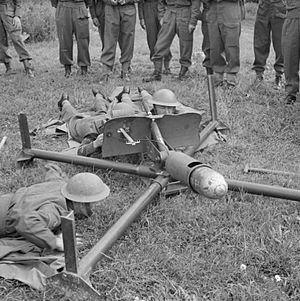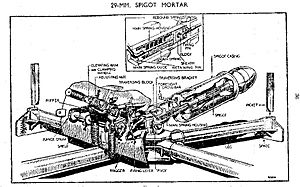Blacker Bombard facts for kids
Quick facts for kids 29-mm Spigot Mortar (Blacker Bombard) |
|
|---|---|

Men of the Saxmundham Home Guard prepare to fire a Blacker Bombard during training with War Office instructors, 30 July 1941.
|
|
| Type | Anti-tank mortar |
| Place of origin | United Kingdom |
| Service history | |
| In service | 1941–1942 |
| Used by | British Army Home Guard |
| Wars | World War II |
| Production history | |
| Designer | Lieutenant Colonel Stewart Blacker |
| Designed | 1940 |
| No. built | c. 22,000 |
| Specifications | |
| Mass | 112–407 lb (51–185 kg) |
| Crew | 3–5 |
|
|
|
| Calibre | 29 mm (1.1 in) (nominal calibre – diameter of spigot) |
| Breech | Spigot mortar |
| Traverse | 360° |
| Rate of fire | 6–12 rounds per minute |
| Muzzle velocity | 245 ft/s (75 m/s) |
| Effective firing range | 100 yd (91 m) 20lb bomb |
| Maximum firing range | 450 yd (410 m) 20lb bomb 785 yd (718 m) 14lb bomb |
The Blacker Bombard, also known as the 29-mm Spigot Mortar, was a special weapon designed for soldiers during the early years of World War II. It was created by Lieutenant Colonel Stewart Blacker.
This weapon was meant to help the Home Guard defend against a possible German invasion. At the time, Britain was very short on weapons. Even though some people doubted how good it was, the Bombard was made in large numbers. Few, if any, were actually used in real battles.
Contents
Developing the Blacker Bombard
After the Battle of France and the evacuation of British soldiers from Dunkirk in 1940, it looked like Germany might invade Great Britain. The British Army didn't have enough weapons to defend the country. Many anti-tank guns were left behind in France. Only a few were left in Britain, and there wasn't much ammunition for them.
Because of this shortage, the best weapons went to the regular army. The Home Guard, a volunteer defense force, had to use older or makeshift weapons. One of these was the Blacker Bombard. It was designed by Lieutenant Colonel Stewart Blacker.
Blacker had been interested in a type of weapon called a 'spigot mortar' since the 1930s. Unlike normal mortars, a spigot mortar doesn't have a barrel. Instead, it has a steel rod (the 'spigot') on a base. The bomb itself has the explosive charge in its tail. When fired, the bomb slides onto the spigot, which sets off the charge and launches the bomb.
Blacker first tried to make a lighter mortar for platoons. This design was called the Arbalest, but the army didn't choose it. Blacker then changed his design to create an anti-tank weapon. He finally succeeded and named it the Blacker Bombard.
When World War II began, Blacker offered his Bombard to the War Office (a government department). They didn't accept it at first. However, he was introduced to a secret department called MD1, which developed weapons for resistance groups. The head of MD1, Major Millis Jefferis, liked the Bombard. He thought it could be used against tanks and as artillery.
Even though some officials had doubts, Prime Minister Winston Churchill saw a demonstration of the weapon on August 18, 1940. Churchill liked it and ordered it to be produced quickly. It was meant to be a temporary anti-tank weapon for the Home Guard until more modern guns were available.
General Alan Brooke, who was in charge of Home Forces, also had doubts about the Bombard. But he believed its simple design meant even younger soldiers could use it. About 22,000 Bombards were eventually made.
How the Bombard Was Designed
The Blacker Bombard was a 29mm spigot mortar. It weighed about 112 pounds by itself. With its mobile platform and tools, it weighed around 407 pounds.
It used two types of ammunition:
- A 20-pound bomb for attacking tanks.
- A lighter 14-pound bomb for attacking groups of people.
The 20-pound bomb could fly up to about 450 yards. However, it was most effective at short ranges, around 75 to 100 yards. When it hit a tank, it could cause a lot of damage. But it often didn't pierce the tank's armor because it didn't fly fast enough. The 14-pound bomb could reach about 785 yards.
The Bombard needed a crew of three to five people to operate it. It was loaded from the front, which made it slow to fire. It could fire about six to twelve rounds per minute. Because of this, it was important for the weapon to be well hidden and to hit the target with the first shot.
The anti-tank bombs had some issues. Their fuses were not very sensitive, so they sometimes passed through targets without exploding. When they did explode, pieces of the bomb could fly back towards the crew.
The Bombard was usually set up in a fixed position. It could be attached to a large cross-shaped platform or a concrete base. These positions were often near defensive spots like roadblocks. The weapon was usually placed in a pit with ammunition nearby.
The entire Bombard, including the mortar, base, legs, ground stakes, hammers, and toolbox, could be carried by five people.
Operational History
The first Blacker Bombards appeared in late 1941. They were given to both regular army units and the Home Guard. By July 1942, about 22,000 Bombards had been made and sent out across the country.
By November 1941, some units were already concerned about the weapon. It was not popular with everyone. Some tried to trade their Bombards for other weapons or refused to use them. However, some historians say that getting the Bombard showed that the government was taking the Home Guard seriously. It also gave weapons to Home Guard members who otherwise had none.
It seems that some Bombards were used by the British Army in the Western Desert Campaign. They were used against enemy soldiers, but their heavy weight might have limited their use. The design of the Bombard also inspired the Royal Navy's anti-submarine weapon called the Hedgehog.
Many concrete bases for Bombards were built, and a good number of them can still be seen today in the United Kingdom. A survey in the late 1990s found 351 of these surviving bases.
Who Used the Blacker Bombard?
See also
- Smith gun
- Northover Projector
- Spigot gun
- PIAT
- Hedgehog - an anti-submarine spigot mortar




